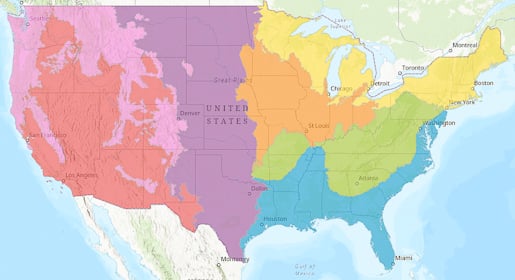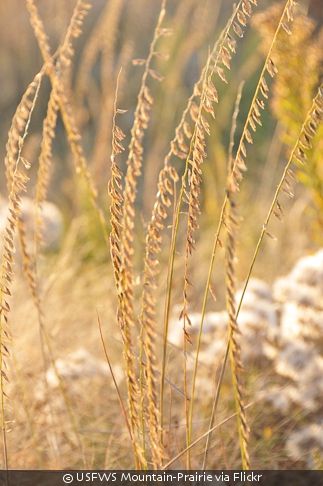Bouteloua curtipendula sideoats grama
Characteristics
Descriptions
Light Requirements
Soil Moisture
Soil Description
Height
Recommended Spacing
Bloom Time
Bloom Color
Hardiness Zone
Description
Bouteloua curtipendula is a compact, warm-season grass with a loose, clumping habit and attractive bluish foliage. The leaf blades are up to 8” long and ¼” wide. The total height of the plant when in seed is only about 2 ½’ to 3’. Its texture is coarser than most other species of grama. Both the inflorescence and ensuing seed heads are visually interesting, consisting of a zigzag stalk with oat-like spikelets dangling to one side. It will turn lovely shades of golden-brown, orange, and even some hints of red. Sideoats grama is native to South Central Canada and much of the U.S., extending southward to Mexico, Central America, and western South America. In the U.S., it's most common in the central region of the country. Sideoats grama is a grassland species that occupies open areas, including prairies, rocky slopes, and forest openings. It also finds its way to roadsides and along railroads.
Cultivation
Recommended Spacing
Space plants 16"-30" on center.
The most common variety of sideoats grama in the regions Izel covers has a loosely clumping habit and long rhizomes that spread. With consistent moisture and lack of competition, it may form a tight, sod-like mat.
Another variety, found primarily in the Southwest and into Mexico and southward, is clumping. It has short, knotty rhizomes and spreads mainly via seed. A third variety, which produces stolons (above-ground stems) is rare and occurs outside our regions.
Companion Plants
Sideoats grama is a common and widespread species, so it's easy to find companions. Add beautiful, pollinator friendly pink-purple blooms with Symphyotrichum oblongifolium (aromatic aster), Liatris aspera (tall blazing star), Echinacea pallida (pale purple coneflower), or Echinacea purpurea (eastern purple coneflower). Other flowering companions include Baptisia bracteata var. leucophaea (longbract wild indigo), Eryngium yuccifolium (button eryngo), Asclepias tuberosa (butterfly milkweed), and Rudbeckia fulgida (orange coneflower). For a short grassland feel, pair it with warm-season companions Schizachyrium scoparium (little bluestem), Sporobolus heterolepis (prairie dropseed). Add in the cool-season grass Koeleria macrantha (prairie junegrass) and sedges like Carex brevior (shortbeak sedge) or Carex bicknellii (Bicknell's sedge).
Additional Notes
A denizen of grasslands, sideoats grama is eaten by grazing animals, for whom it's highly palatable; it's lower on the list of palatable plants for browsers like deer. The foliage feeds grasshoppers, leafhoppers, skipper larvae, and other insects, while songbirds and gamebirds eat the seeds.
The genus was named to honor two Spanish brothers and botanists from the late 18th century: Estéban and Claudio Boutelou. The specific epithet, curtipendula, means shortened and pendulous, and describes the disposition of the seeds. Similarly, the common name sideoats grama, describes the seed disposition as well as their resemblance to oats, which are bold characteristics and make this species easy to identify. Interesting factoid: This species is also found in the South America, where the word commonly used for sod, is grama.

Pricing & Availability
Note: Early spring shipments might include plants that have not yet broken dormancy, or have not been vernalized and will be frost-tender. Please use your best judgment when selecting your preferred ship week.
Why choose plants from the nearest grower? Choosing a the grower closest to you makes it more likely the plants are consistent with your ecoregion and better adapted to your location. In addition, shipping plants shorter distances typically uses fewer resources, something we can all get behind!
BUY MORE, SAVE MORE
$50 off orders of $750 or more
$100 off orders of $1,000 or more
15% off orders of $3,000 or more
Maps, Wetland Status & More
MAP OF NATIVE RANGE
Recorded County Distribution: USDA data.
Native To
| AL, AR, CT, DC, GA, IA, IL, IN, KS, KY, MD, ME, MI, MN, MO, MS, NC, ND, NE, NJ, NY, OH, OK, PA, SC, SD, TN, VA, WI, WV, AZ, CA, CO, FL, ID, LA, MT, NM, OR, TX, UT, WA, WY |
Legal Status
| Endangered | CT, NJ, NY |
| Special Concern | KY |
| Threatened | MI, PA |
Wetland Status
MAP OF WETLAND DELINEATION REGIONS

Interpreting Wetland Status
|
Code |
Status |
Designation |
Comment |
|
OBL |
Obligate Wetland |
Hydrophyte |
Almost always occur in wetlands |
|
FACW |
Facultative Wetland |
Hydrophyte |
Usually occur in wetlands, but may occur in non-wetlands |
|
FAC |
Facultative |
Hydrophyte |
Occur in wetlands and non-wetlands |
|
FACU |
Facultative Upland |
Nonhydrophyte |
Usually occur in non-wetlands, but may occur in wetlands |
|
UPL |
Obligate Upland |
Nonhydrophyte |
Almost never occur in wetlands |
Classification
| Kingdom | Plantae | Plants |
| Subkingdom | Tracheobionta | Vascular plants |
| Superdivision | Spermatophyta | Seed plants |
| Division | Magnoliophyta | Flowering plants |
| Class | Liliopsida | Monocotyledons |
| Subclass | Commelinidae | |
| Order | Cyperales | |
| Family | Poaceae | Grass family |
| Genus | Bouteloua | grama |
| Species | Bouteloua curtipendula | sideoats grama |
ADDITIONAL COMMON NAMES:
sideoats grass. side-oats grama
Plant Sizes
Sizes info
Shipping & Planting
SHIPPING INFO:
Shipping is free on all plants orders!
Your plants will ship using each grower’s preferred method: FedEx Ground, UPS Ground, or Spee-Dee Ground (in select midwestern states). Our growers ship orders Monday through Wednesday. The farther your plants need to travel, the earlier in the week they will ship. The goal is to have all plants delivered by the end of the week.
Shipping plugs:
Plugs are shipped in full flats, sometimes also referred to as trays. Multiple flats can be shipped in a single box. The flats are wrapped in netting or craft paper to secure the plants, and spacers are used between flats to keep the plants from being crushed.
When you unpack your plugs, the plants will have been somewhat flattened by the netting or craft paper. They will straighten out within a couple of days. You may also gently “fluff” them a bit to speed up the process. In some cases, your plants might have been cut back before packing, if the grower deemed them to have become too tall for safe packaging. Don’t worry, though, these guys know what they’re doing and would not compromise the health of the plants. They’ll fill back in in no time.
After receiving your plants’ journey in a dark box, it will be important to acclimate them to sunlight again. Over a couple of days, you should gradually move them into their preferred light exposure, and water them as per their requirement.
Although we always recommend putting your plants in the ground as soon as possible, they can stay healthy in the flats for a considerable amount of time. The key is to respect their growing requirements: if the species requires full sun, do not store them in the shade. If it is best adapted to dry soil, do not over-water.
PLANTING INFO:
Planting plugs:
We consider plugs ready to ship when the plants’ roots have filled the entire liner cell and the plants can easily be pulled out. In some cases you will have to go about it gently, wiggling the plant by the crown, and possibly squeezing the bottom of the liner to compress the growing medium and release the roots. Other times, the plants will appear to be root bound. They are not in the traditional sense. The plants are healthy but they have used up all the growing medium available to them. Plugs are at an aggressive stage of growth. As soon as planted the roots will immediately expand into your native soil. They establish faster than plants in larger containers, because they don’t have the luxury of a lot of growing media that can inhibit the roots from venturing outside of their comfort zone.
We are not going to address area preparation because the process can be complex and is always site-specific. However, as a rule, we recommend disturbing the soil as little as possible, and we do not recommend amending the soil. If you chose the right plant for the right conditions they will thrive. Any disturbance and amendments will only encourage weeds to emerge that never had a chance to do so before.
Installing plugs cannot be easier: dig a hole large enough for the roots to fit snugly inside, then water them in to eliminate air gaps. We recommend using a soil knife, sometimes referred to as hori hori, or a drill-adapted auger if it’s a large installation. If you use an auger, you will need a powerful drill. Depending on the size of the project and the type of soil, the process can be beyond what an average drill will bear. Mulching is recommended after installation to help keep weeds down while the plants establish. Be sure to keep it away from the crown of the plants. For large projects, you may want to mulch the area before planting, rather than tiptoeing through it after the fact. As a side note: if you are installing plugs in the fall, you might want to plant them so that the crown is about ¾” lower than the surrounding soil. The winter’s freeze/thaw cycles can push plugs out if the roots did not have enough time to establish and anchor them in.





